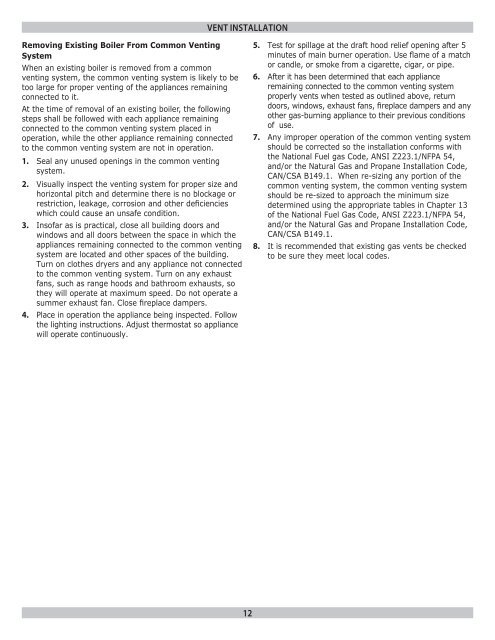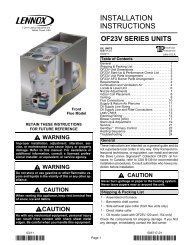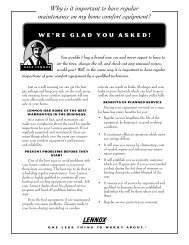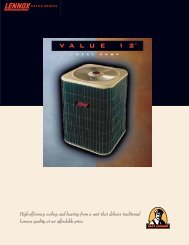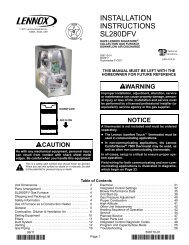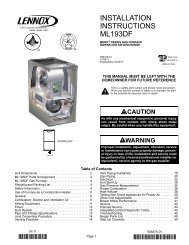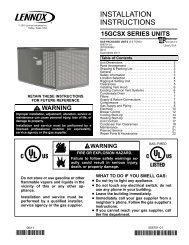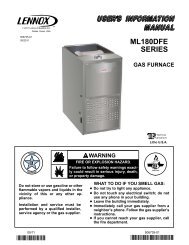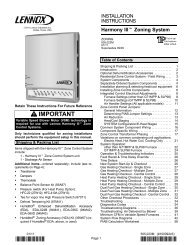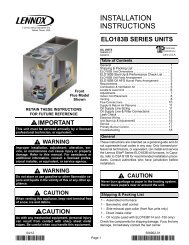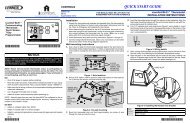GWB8-IE Boiler Installation Manual - Lennox
GWB8-IE Boiler Installation Manual - Lennox
GWB8-IE Boiler Installation Manual - Lennox
Create successful ePaper yourself
Turn your PDF publications into a flip-book with our unique Google optimized e-Paper software.
VENT INSTALLATION<br />
Removing Existing <strong>Boiler</strong> From Common Venting<br />
System<br />
When an existing boiler is removed from a common<br />
venting system, the common venting system is likely to be<br />
too large for proper venting of the appliances remaining<br />
connected to it.<br />
At the time of removal of an existing boiler, the following<br />
steps shall be followed with each appliance remaining<br />
connected to the common venting system placed in<br />
operation, while the other appliance remaining connected<br />
to the common venting system are not in operation.<br />
1. Seal any unused openings in the common venting<br />
system.<br />
2. Visually inspect the venting system for proper size and<br />
horizontal pitch and determine there is no blockage or<br />
restriction, leakage, corrosion and other deficiencies<br />
which could cause an unsafe condition.<br />
3. Insofar as is practical, close all building doors and<br />
windows and all doors between the space in which the<br />
appliances remaining connected to the common venting<br />
system are located and other spaces of the building.<br />
Turn on clothes dryers and any appliance not connected<br />
to the common venting system. Turn on any exhaust<br />
fans, such as range hoods and bathroom exhausts, so<br />
they will operate at maximum speed. Do not operate a<br />
summer exhaust fan. Close fireplace dampers.<br />
4. Place in operation the appliance being inspected. Follow<br />
the lighting instructions. Adjust thermostat so appliance<br />
will operate continuously.<br />
5. Test for spillage at the draft hood relief opening after 5<br />
minutes of main burner operation. Use flame of a match<br />
or candle, or smoke from a cigarette, cigar, or pipe.<br />
6. After it has been determined that each appliance<br />
remaining connected to the common venting system<br />
properly vents when tested as outlined above, return<br />
doors, windows, exhaust fans, fireplace dampers and any<br />
other gas-burning appliance to their previous conditions<br />
of use.<br />
7. Any improper operation of the common venting system<br />
should be corrected so the installation conforms with<br />
the National Fuel gas Code, ANSI Z223.1/NFPA 54,<br />
and/or the Natural Gas and Propane <strong>Installation</strong> Code,<br />
CAN/CSA B149.1. When re-sizing any portion of the<br />
common venting system, the common venting system<br />
should be re-sized to approach the minimum size<br />
determined using the appropriate tables in Chapter 13<br />
of the National Fuel Gas Code, ANSI Z223.1/NFPA 54,<br />
and/or the Natural Gas and Propane <strong>Installation</strong> Code,<br />
CAN/CSA B149.1.<br />
8. It is recommended that existing gas vents be checked<br />
to be sure they meet local codes.<br />
12


